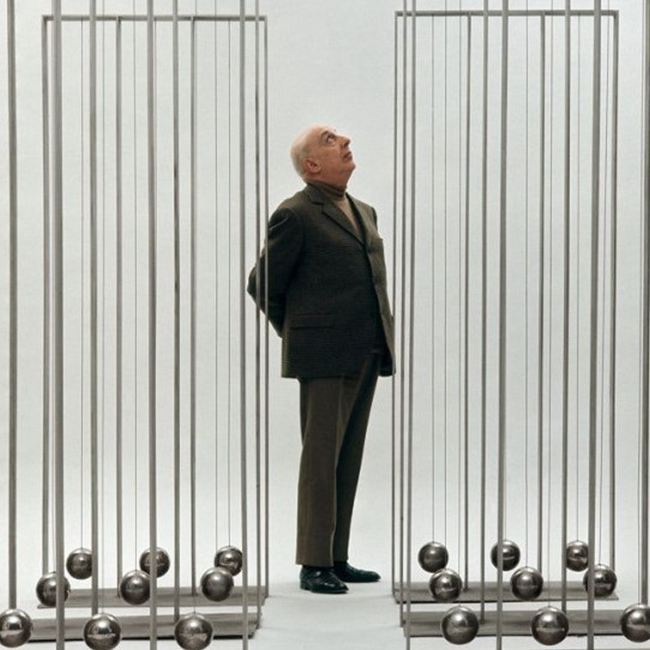Fausto Melotti
Fausto Melotti (Rovereto, 1901 - Milan, 1986) was an Italian sculptor ascribable to the Abstract Art. His work, characterized by an evident evolution over the years, is the result of a personal need to find a space defined as "musical", obtained by the use of various materials including plaster, marble, steel and bronze, but also metal and ceramic wires.
Trained in Rovereto, Melotti attends the same literary and intellectual circles as the futurist Fortunato Depero.
Moving to Turin and then to Milan, Melotti began his career as a sculptor around 1922, enrolling in the Accademia di Brera in 1928 and becoming a pupil of Adolfo Wildt and Lucio Fontana. The numerous classical busts that portray friends and relatives are dated back to this period (Portrait of Fortunato Depero, 1929; Portrait of the mother Albina Fait, 1929-30).
Meeting the architect Gio Ponti in 1930 determined an increasingly closer approach to the potential of ceramics, also thanks to his employment at the prestigious Richard porcelain factory Ginori, where the latter worked.
Melotti quickly became interested in a more modern style, joining the Parisian movement "Abstraction-Création" and hanging out with the artists who revolved around the Il Milione gallery, among which Lucio Fontana, Josef Albers and Vasily Kandinsky, just to mention a few. It is precisely at Il Milione that Melotti had his first personal exhibition, in 1935.
During the Second World War he lived in Rome, where he collaborated again with Giò Ponti, Figini and Pollini, and he also engaged in poetry, publishing the collection The sad Minotaur in 1944.
The Fifties and the Sixties represented a period of new inspirations, awarded and prized abroad and, finally, in Italy: in fact, in 1951 Melotti won the Triennale Grand Prix and, from 1967 on, a series of exhibitions took place in Italy and abroad.
Shortly after the sculptor's passing in 1986, the 42nd Biennale di Venezia of Visual Arts awarded him with the Leone d’Oro to the Memory.

Fausto Melotti (Rovereto, 1901 - Milan, 1986) was an Italian sculptor ascribable to the Abstract Art. His work, characterized by an evident evolution over the years, is the result of a personal need to find a space defined as "musical", obtained by the use of various materials including plaster, marble, steel and bronze, but also metal and ceramic wires.
Trained in Rovereto, Melotti attends the same literary and intellectual circles as the futurist Fortunato Depero.
Moving to Turin and then to Milan, Melotti began his career as a sculptor around 1922, enrolling in the Accademia di Brera in 1928 and becoming a pupil of Adolfo Wildt and Lucio Fontana. The numerous classical busts that portray friends and relatives are dated back to this period (Portrait of Fortunato Depero, 1929; Portrait of the mother Albina Fait, 1929-30).
Meeting the architect Gio Ponti in 1930 determined an increasingly closer approach to the potential of ceramics, also thanks to his employment at the prestigious Richard porcelain factory Ginori, where the latter worked.
Melotti quickly became interested in a more modern style, joining the Parisian movement "Abstraction-Création" and hanging out with the artists who revolved around the Il Milione gallery, among which Lucio Fontana, Josef Albers and Vasily Kandinsky, just to mention a few. It is precisely at Il Milione that Melotti had his first personal exhibition, in 1935.
During the Second World War he lived in Rome, where he collaborated again with Giò Ponti, Figini and Pollini, and he also engaged in poetry, publishing the collection The sad Minotaur in 1944.
The Fifties and the Sixties represented a period of new inspirations, awarded and prized abroad and, finally, in Italy: in fact, in 1951 Melotti won the Triennale Grand Prix and, from 1967 on, a series of exhibitions took place in Italy and abroad.
Shortly after the sculptor's passing in 1986, the 42nd Biennale di Venezia of Visual Arts awarded him with the Leone d’Oro to the Memory.
